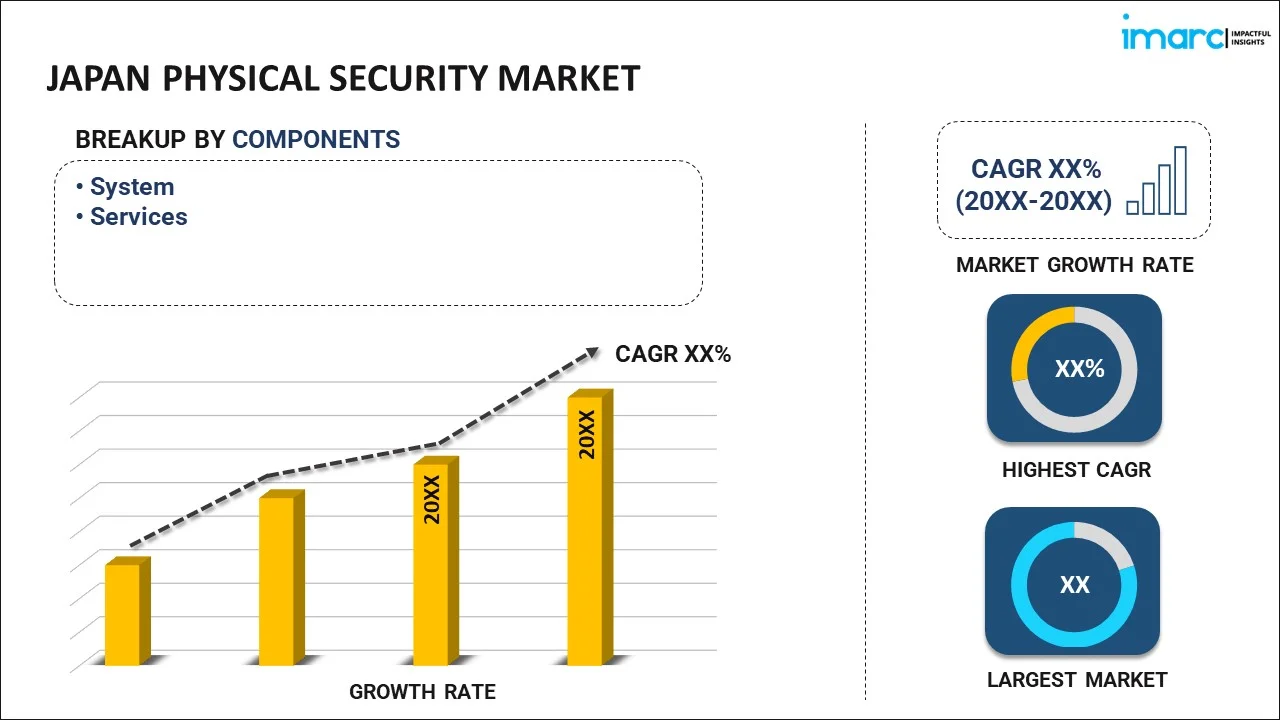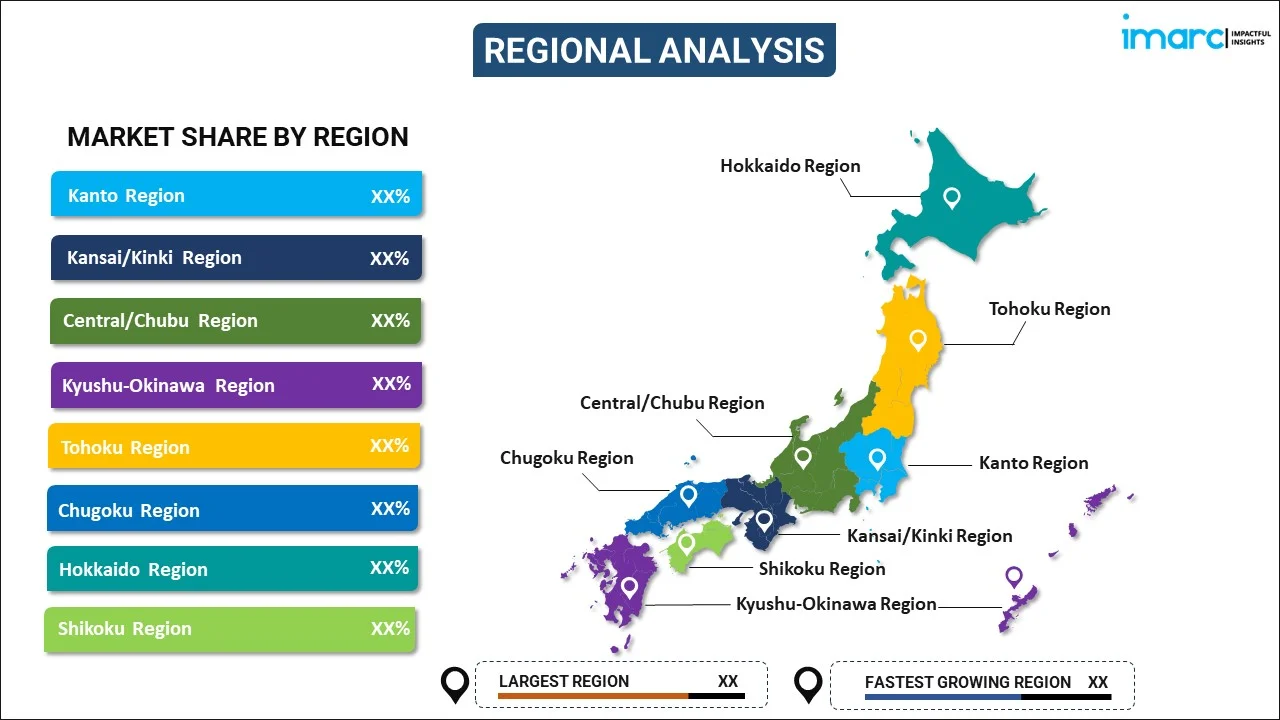
Japan Physical Security Market Report by Component (System, Services), Enterprise Size (Large Enterprises, Small and Medium-sized Enterprises), Industry Vertical (Retail, Transportation, Residential, IT and Telecom, BFSI, Government, and Others), and Region 2025-2033
Market Overview:
Japan physical security market size reached USD 5.9 Billion in 2024. Looking forward, IMARC Group expects the market to reach USD 11.8 Billion by 2033, exhibiting a growth rate (CAGR) of 7.33% during 2025-2033. The increasing prevalence of various physical threats, such as terrorism, theft, vandalism, and natural disasters, coupled with the growing need for advanced physical security solutions to protect assets, infrastructure, and people, is driving the market.
|
Report Attribute
|
Key Statistics
|
|---|---|
|
Base Year
|
2024 |
|
Forecast Years
|
2025-2033
|
|
Historical Years
|
2019-2024
|
| Market Size in 2024 | USD 5.9 Billion |
| Market Forecast in 2033 | USD 11.8 Billion |
| Market Growth Rate (2025-2033) | 7.33% |
Physical security refers to the protection of physical assets, resources, and personnel from unauthorized access, damage, and threats. It encompasses measures such as access control, surveillance, barriers, and security personnel to safeguard physical spaces. This includes securing buildings, facilities, equipment, and other tangible assets. Physical security strategies aim to deter, detect, and respond to potential security breaches and risks, ensuring the safety and integrity of the physical environment. Common components of physical security include locks, alarms, video surveillance, security guards, and perimeter defenses. By implementing robust physical security measures, organizations and individuals can minimize the likelihood of unauthorized access, theft, vandalism, or other physical threats. A comprehensive physical security plan takes into account the specific needs and vulnerabilities of a particular location or asset, and it is often designed to work in conjunction with digital security systems to provide comprehensive protection.
Japan Physical Security Market Trends:
The physical security market in Japan is witnessing robust growth, driven primarily by the escalating regional security concerns. With the surge in terrorist activities in Japan, the demand for stringent security measures has intensified. Consequently, governments and enterprises alike are increasingly investing in advanced physical security solutions. Moreover, the rapid advancements in technology have revolutionized the market landscape, fostering the adoption of innovative security systems. As a result, the integration of cutting-edge technologies such as biometrics, video surveillance, and access control has become imperative for ensuring comprehensive security protocols. Furthermore, the growing awareness regarding the significance of safeguarding critical infrastructure and assets has propelled the demand for sophisticated physical security solutions. Additionally, the expanding commercial sector, including retail, banking, and healthcare, has significantly contributed to the market's growth trajectory. Consequently, the need to combat cyber threats, coupled with the rising instances of data breaches, has further stimulated the deployment of robust physical security solutions, fueling the market's expansion.
Japan Physical Security Market Segmentation:
IMARC Group provides an analysis of the key trends in each segment of the market, along with forecasts at the country level for 2025-2033. Our report has categorized the market based on component, enterprise size, and industry vertical.
Component Insights:

- System
- Physical Access System
- Video Surveillance System
- Perimeter Intrusion and Detection
- Physical Security Information Management
- Others
- Services
- System Integration
- Remote Monitoring
- Others
The report has provided a detailed breakup and analysis of the market based on the component. This includes system (physical access system, video surveillance system, perimeter intrusion and detection, physical security information management, and others) and services (system integration, remote monitoring, and others).
Enterprise Size Insights:
- Large Enterprises
- Small and Medium-sized Enterprises
A detailed breakup and analysis of the market based on the enterprise size have also been provided in the report. This includes large enterprises and small and medium-sized enterprises.
Industry Vertical Insights:
- Retail
- Transportation
- Residential
- IT and Telecom
- BFSI
- Government
- Others
The report has provided a detailed breakup and analysis of the market based on the industry vertical. This includes retail, transportation, residential, IT and telecom, BFSI, government, and others.
Regional Insights:

- Kanto Region
- Kansai/Kinki Region
- Central/ Chubu Region
- Kyushu-Okinawa Region
- Tohoku Region
- Chugoku Region
- Hokkaido Region
- Shikoku Region
The report has also provided a comprehensive analysis of all the major regional markets, which include Kanto Region, Kansai/Kinki Region, Central/ Chubu Region, Kyushu-Okinawa Region, Tohoku Region, Chugoku Region, Hokkaido Region, and Shikoku Region.
Competitive Landscape:
The market research report has also provided a comprehensive analysis of the competitive landscape. Competitive analysis such as market structure, key player positioning, top winning strategies, competitive dashboard, and company evaluation quadrant has been covered in the report. Also, detailed profiles of all major companies have been provided.
Japan Physical Security Market Report Coverage:
| Report Features | Details |
|---|---|
| Base Year of the Analysis | 2024 |
| Historical Period | 2019-2024 |
| Forecast Period | 2025-2033 |
| Units | Billion USD |
| Scope of the Report | Exploration of Historical Trends and Market Outlook, Industry Catalysts and Challenges, Segment-Wise Historical and Future Market Assessment:
|
| Components Covered |
|
| Enterprise Sizes Covered | Large Enterprises, Small and Medium-sized Enterprises |
| Industry Verticals Covered | Retail, Transportation, Residential, IT and Telecom, BFSI, Government, Others |
| Regions Covered | Kanto Region, Kansai/Kinki Region, Central/ Chubu Region, Kyushu-Okinawa Region, Tohoku Region, Chugoku Region, Hokkaido Region, Shikoku Region |
| Customization Scope | 10% Free Customization |
| Post-Sale Analyst Support | 10-12 Weeks |
| Delivery Format | PDF and Excel through Email (We can also provide the editable version of the report in PPT/Word format on special request) |
Key Questions Answered in This Report:
- How has the Japan physical security market performed so far and how will it perform in the coming years?
- What has been the impact of COVID-19 on the Japan physical security market?
- What is the breakup of the Japan physical security market on the basis of component?
- What is the breakup of the Japan physical security market on the basis of enterprise size?
- What is the breakup of the Japan physical security market on the basis of industry vertical?
- What are the various stages in the value chain of the Japan physical security market?
- What are the key driving factors and challenges in the Japan physical security?
- What is the structure of the Japan physical security market and who are the key players?
- What is the degree of competition in the Japan physical security market?
Key Benefits for Stakeholders:
- IMARC’s industry report offers a comprehensive quantitative analysis of various market segments, historical and current market trends, market forecasts, and dynamics of the Japan physical security market from 2019-2033.
- The research report provides the latest information on the market drivers, challenges, and opportunities in the Japan physical security market.
- Porter's five forces analysis assist stakeholders in assessing the impact of new entrants, competitive rivalry, supplier power, buyer power, and the threat of substitution. It helps stakeholders to analyze the level of competition within the Japan physical security industry and its attractiveness.
- A competitive landscape allows stakeholders to understand their competitive environment and provides an insight into the current positions of key players in the market.
Need more help?
- Speak to our experienced analysts for insights on the current market scenarios.
- Include additional segments and countries to customize the report as per your requirement.
- Gain an unparalleled competitive advantage in your domain by understanding how to utilize the report and positively impacting your operations and revenue.
- For further assistance, please connect with our analysts.
 Inquire Before Buying
Inquire Before Buying
 Speak to an Analyst
Speak to an Analyst
 Request Brochure
Request Brochure
 Request Customization
Request Customization




.webp)




.webp)












